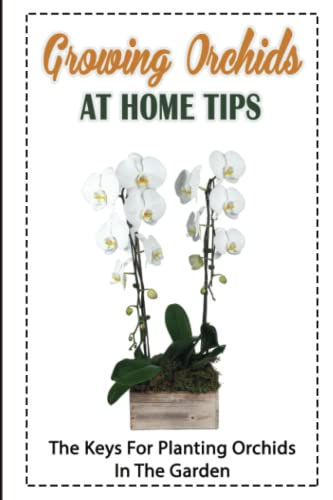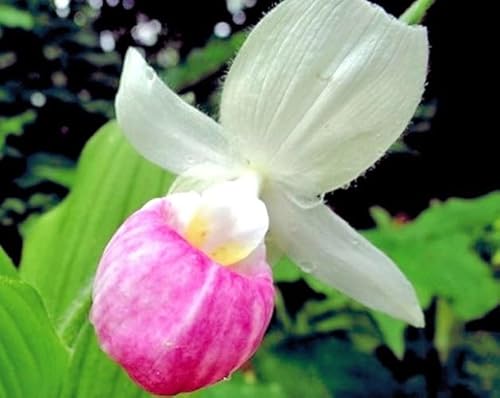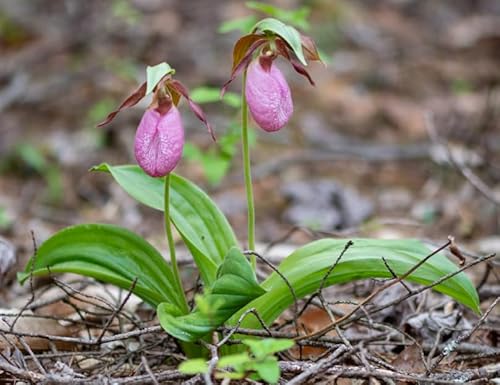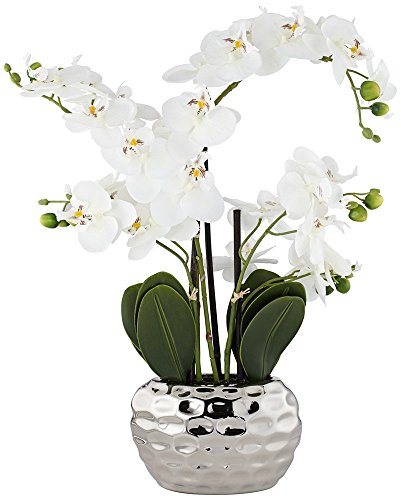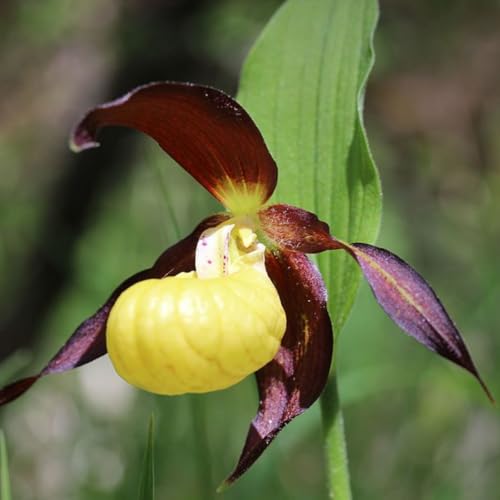Stephen VK uses cypress mulch (on top of LECA) for catasetinae:
You are using an out of date browser. It may not display this or other websites correctly.
You should upgrade or use an alternative browser.
You should upgrade or use an alternative browser.
Rock Wool + LECA
- Thread starter Ray
- Start date

Help Support Slippertalk Orchid Forum:
This site may earn a commission from merchant affiliate
links, including eBay, Amazon, and others.
When I grew in a greenhouse, it was not at all necessary, as I kept the humidity high enough that evaporation from the medium did not outdo the wicking. Here in NC, out on my deck, the RH is usually high enough that it’s not a problem, either, but indoors now is a bit of a challenge.
I prefer to simply water more often to compensate, but have played with any number of “top dressings”, ranging from gravel, to sphagnum, to rock wool, to clear plastic disks.
Hey Ray so far what technique for mixing has worked best for you?
1. LECA+ ROCKWOOL evenly mixed in top to bottom
2. Leca + Rockwool alternating in layers. Leca, rockwool, leca, rockwool.
3. Leca 66% bottom 33% rockwool on the top.
Last edited:
I have been using #2 (the parfait method) for the last year and I think it works well for the plants in it. I think it preserves aeration and gives good resistance to evaporation. I have settled on an every five day watering schedule in my indoor/LED lighting setup. I may keep large Cattleyas in #3, but I am going to compare 2 and 3 with some of them.
Most of the 2-component experiments have been with a “uniform” mixture of the two ingredients; it’s the ratio I’m playing with most.Hey Ray so far what technique for mixing has worked best for you?
1. LECA+ ROCKWOOL evenly mixed in top to bottom
2. Leca + Rockwool alternating in layers. Leca, rockwool, leca, rockwool.
3. Leca 66% bottom 33% rockwool on the top.
I’ve only tried the “parfait” method on one plant so far, comparing it to a sibling in the blend. Too early to discern a difference, and it’s might hard to draw any solid conclusions from such a small comparison.
I’ve never tried #3.
1. Both of Ray's photos show a layer of Leca on the bottom, Is this up to the level aeration holes?
2. I am using the first method but with Diatomite in the mix. Our apartment must be super dry because we water a couple times a day. If we miss 2 days the reservoirs are dry. Does anyone have a source for Diatomite?
2. I am using the first method but with Diatomite in the mix. Our apartment must be super dry because we water a couple times a day. If we miss 2 days the reservoirs are dry. Does anyone have a source for Diatomite?
The drawings (not photos) were merely meant to indicate the concept. In practice, in the case of the mix of components, there are both LECA pellets and rockwool cubes in the reservoir.1. Both of Ray's photos show a layer of Leca on the bottom, Is this up to the level aeration holes?
2. I am using the first method but with Diatomite in the mix. Our apartment must be super dry because we water a couple times a day. If we miss 2 days the reservoirs are dry. Does anyone have a source for Diatomite?

$29.99 ($6.00 / Count)
5 Small Lady Slipper Orchids, Pink Orchids Plants Live Lady Slipper, Ornament Orchids Plant Root, No Leaf
KIM MARIE SMITH

$31.33 ($3.13 / Fl Oz)
Vitabath Orchid Intrigue Everyday Skincare Set Moisturizing Shower Gel Wash, Reviving Lotion & Exfoliating Body Scrubber Pouf - Alluring Foam Cleanser & Dry Skin Hydration for Women & Men
Class01 USA (we record serial numbers)

$58.99 ($5.90 / Count)
10 Small Lady Slipper Orchids, Pink Orchids Plants Live Lady Slipper, Ornament Orchids Plant Root, No Leaf
KIM MARIE SMITH

$16.50 ($1.65 / Count)
JMSolution Active Orchid Moisture-Korean facial Skin Care Mask- Hydrating-Orchid extract-Hydrating Moisture -10 sheets for dry skin
MABLEST LLC

$24.98 ($24.98 / Fl Oz)
SeoulCeuticals Chebula Active Serum for Face - Korean Skin Care Anti Aging Natural K Beauty Skincare With Hyaluronic Acid + Spotted Orchid for Healthy, Youthful Glowing Skin 1oz
Digital Beauty Group

$30.49 ($30.49 / Count)
$32.99 ($32.99 / Count)
Body & Skin Care Set, Spa Kit, Self-care Relaxation Gifts, Skin Care Collection with Essential Oils, Spa Gift Basket, Orchid Jasmine Bath and Body Gift Set Pampering, Birthday Home Spa Gifts
hailida

$9.95 ($14.63 / Fl Oz)
Eternal Essence Oils 2 Pack 10ml Premium Fragrance Oil - Enchanted Orchid & Water Lily - for Candle, Soap Making, Aromatherapy, Diffusers, Home Care, & Humidifiers
eternal essence oils

$29.99 ($15.00 / Count)
2 Pink Lady Slipper Orchid Plant Live Bud Roots, Live Orchid Plants Bud for Planting, Rare Orchids Plant
RACHEAL LEE BARRETT

$29.00 ($14.50 / Fl Oz)
CoQ10 & Stem Cell Rejuvenation Cream - Fight Oxidative Stress, Reduce Wrinkles, Promote Youthful Skin. Goji Berry & Orchid Extracts. 2 oz.
Advanced Skincare Shop

$22.15
$44.00
Understanding Orchids: An Uncomplicated Guide to Growing the World's Most Exotic Plants
Amazon.com

$40.09 ($40.09 / Count)
$45.98 ($45.98 / Count)
hypehouse Allen + roth 8 in. Orchid Pot with Saucer White
Low Price Home Goods
I need to be clear that I am not using a reservoir/SH method. I use Aircone pots for maximum aeration and water from the top. I want maximum aeration and a fertigation schedule that is about every 5 days. This is because I want to be able to be gone for a week without watering. With plants acclimated to watering every 5 days I can do this.
I have the "Modern Moisture Retentive Mix" from Orchids Limited that contains rockwool mixed with coarse large perlite. Would the perlite work the same way as the LECA to provide some aeration? I want to move all of my paphs to this mix once they quit blooming so that I don't have to think about it as much as I do when they are in a bark mix, and I also worry about the ones I have in pure sphagnum being too moist.
While there maybe some similarities, especially considering the large particle size, I found that perlite tends to disintegrate over time, forming a sludge at the bottom of the pot.
Happypaphy7
Paphlover
You can look up some posts or ask directly to Tony who switched from more conventional organic based mix to a mix of rockwool cubes and perlite. His paphs, mostly mutliflora, go great he reports.I have the "Modern Moisture Retentive Mix" from Orchids Limited that contains rockwool mixed with coarse large perlite. Would the perlite work the same way as the LECA to provide some aeration? I want to move all of my paphs to this mix once they quit blooming so that I don't have to think about it as much as I do when they are in a bark mix, and I also worry about the ones I have in pure sphagnum being too moist.
I think adding perlite instead of LECA would provide much better aeration and less moisture. So, perlite might not be the great addition if you want S/H as it would cut the movement of water upward, but for non-S/H, I see it works perfectly well for many orchids.
I have only ever tried Catasetum type plants in the rockwool only mix with good results. I have not yet dared to try my paphs in rockwool mix although I'm thinking of trying rockwool & perlite mix this year on a few of my paphs.
Happypaphy7
Paphlover
One of the things I don't like about perlite is that they break or grind and leaves powder residues behind. I was thinking by mixing perlite with rockwool, rockwool might hold in much of that powder on its textured surface? maybe just a wishful thinking hahaWhile there maybe some similarities, especially considering the large particle size, I found that perlite tends to disintegrate over time, forming a sludge at the bottom of the pot.
When I first switched to a rockwool mix I substituted LECA for perlite when #3 perlite was scarce and it was disastrous. Every plant I had in rockwool and LECA suffered severe or total root loss in the second year and I lost a few choice plants including two adductum and roths 'Charles E'. I'm not sure why there was such a difference but once I figured it out and got the salvageable plants into rockwool and perlite they started to recover.
Thinking back to my earliest experiments that led to S/H culture, perlite wicked really well, but was actually less airy than LECA, as the closer-to-spherical LECA balls do not pack as tightly as irregularly-shaped perlite chunks.I think adding perlite instead of LECA would provide much better aeration and less moisture.
What pretreatment of the LECA did you do? There appears to be a LOT of variability in the reight-out-of-the-bag cleanliness. I soak everything in an excess of water (1 gallon LECA in a 5-gallon bucket filled to the top) for several days prior to use and have never had an issue.When I first switched to a rockwool mix I substituted LECA for perlite when #3 perlite was scarce and it was disastrous. Every plant I had in rockwool and LECA suffered severe or total root loss in the second year and I lost a few choice plants including two adductum and roths 'Charles E'. I'm not sure why there was such a difference but once I figured it out and got the salvageable plants into rockwool and perlite they started to recover.
I've never pretreated LECA.
Happypaphy7
Paphlover
I never pretreated LECA and never had any issues. By the way, I use LECA (hydroton, mostly quite consistent in size and shape in the spherical shape) for the bottom most layer on many plants. I would also add them with orchiata for most of my orchids.
I'm happy with it.
I'm happy with it.
Being a ceramic engineer and ceramist, I am pretty familiar with the various manufacturing processes involved - choice of clay and binders, pelletizing, firing and quenching. Unfortunately, every one of those can differ among brands.I've never pretreated LECA.
Back in the time of Aliflor, which I believe came out of Brazil, they used diesel fuel as the binder, figuring that during firing, it would help literally fuel the process and provide extra porosity when it burned out. Unfortunately, they started getting skimpy on the firing and several containerloads reeked of fuel and were unusable.
The product I relabeled and sold as PrimeAgra use a sodium-based, organic binder instead. Again, if fired properly, it would burn off, but often, there was a sodium salt residue, so I always recommended soaking it well in advance of use.
There's no telling what's in them, so I always presoak.
You should be aware that Hydroton is no longer manufactured and some are packaging other brands as if it still was.I never pretreated LECA and never had any issues. By the way, I use LECA (hydroton, mostly quite consistent in size and shape in the spherical shape) for the bottom most layer on many plants. I would also add them with orchiata for most of my orchids.
I'm happy with it.
Ray, since Hydroton is a brand, how can someone put something else in a Hydroton bag? How do you try and get the good stuff?Being a ceramic engineer and ceramist, I am pretty familiar with the various manufacturing processes involved - choice of clay and binders, pelletizing, firing and quenching. Unfortunately, every one of those can differ among brands.
Back in the time of Aliflor, which I believe came out of Brazil, they used diesel fuel as the binder, figuring that during firing, it would help literally fuel the process and provide extra porosity when it burned out. Unfortunately, they started getting skimpy on the firing and several containerloads reeked of fuel and were unusable.
The product I relabeled and sold as PrimeAgra use a sodium-based, organic binder instead. Again, if fired properly, it would burn off, but often, there was a sodium salt residue, so I always recommended soaking it well in advance of use.
There's no telling what's in them, so I always presoak.
You should be aware that Hydroton is no longer manufactured and some are packaging other brands as if it still was.
Happypaphy7
Paphlover
The one I bought came in an original bag saying hydrton. so I hope it is what it says it is.
Thanks for the warning about potential chemical residues in some products.
Thanks for the warning about potential chemical residues in some products.
Well... It's a German brand and apparently the company no longer exists, so who's to know that someone is selling a knock-off with that label?Ray, since Hydroton is a brand, how can someone put something else in a Hydroton bag? How do you try and get the good stuff?
I have seen changes in the product labeled as "Hydroton", so again I'll ask, who's to know if it's a manufacturing change or a product substitution?




